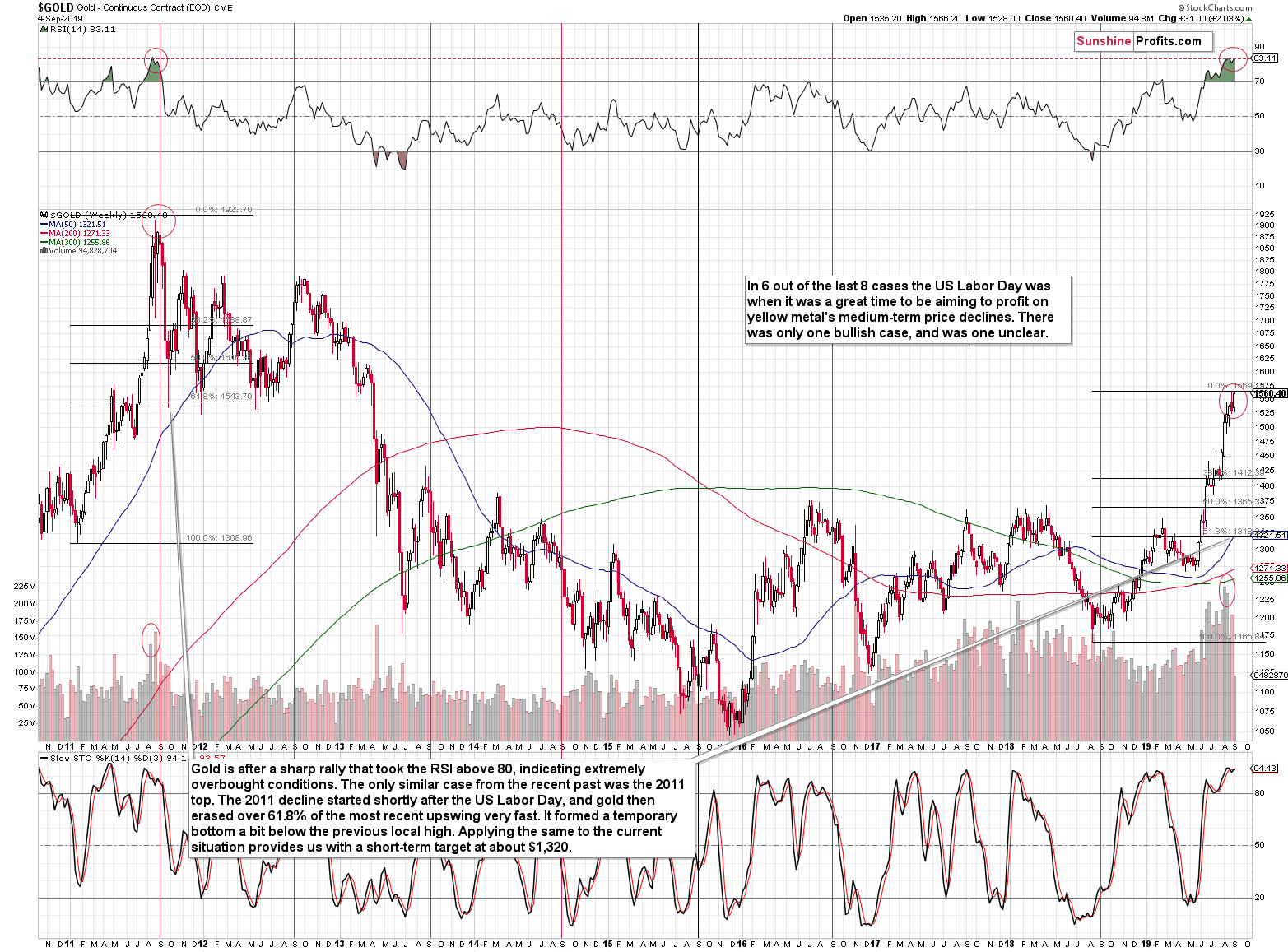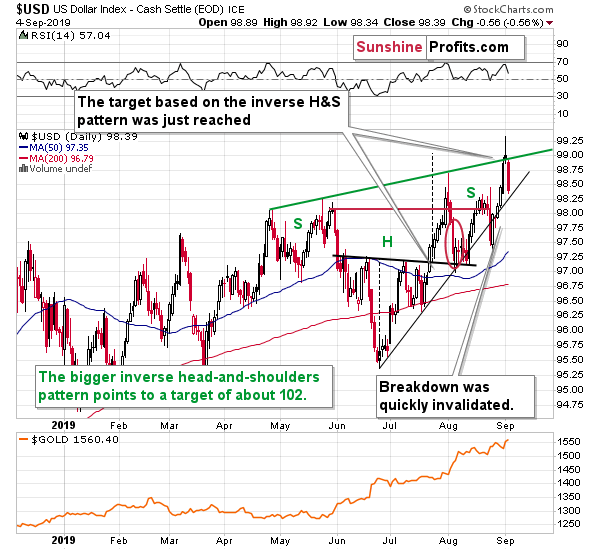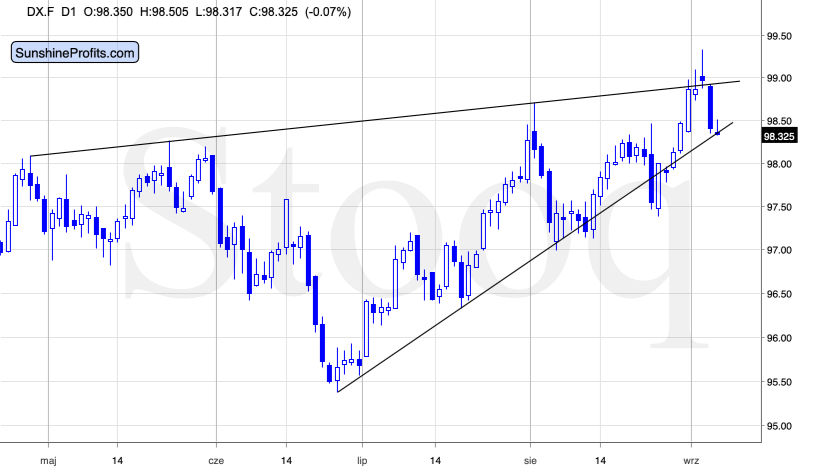Briefly: in our opinion, full (250% of the regular size of the position) speculative short position in gold, silver, and mining stocks are justified from the risk/reward point of view at the moment of publishing this Alert. We are moving back in with the silver position.
Gold just had to do it. It had to move to new intraday highs. Even if it was just for a few hours, and even if it was just a $1.20 breakout. What does the move to new highs imply? Does it invalidate the analogy to what happened in 2011 or after almost all Labor Days since that time?
The analogy to 2011 is not only not invalidated by yesterday's session, it is actually more confirmed now. Why would this be the case? After all, in 2011, gold topped right after the US Labor Day. However, it also topped a bit above the previous high ($5.80) and then invalidated this breakout. In terms of time, the situation is not identical, but in terms of relative price movements, it's now much more like 2011 than it was before yesterday's session. On the other hand, a daily delay in an analogy describing a pattern that's happening once per year means very little. Consequently, taking both perspectives into account, the analogy to happened in 2011 and - more importantly - what happened after almost all U.S. Labor Days since 2011 - remains on.
We put the part about other years in bold, as we received a question why we view the 2011 analogy as important, even though the situation back then was different, for instance with regard to silver, which was already after a major top. The reply is that the analogy to 2011 is not the most important thing - it's only the most visible and interesting one.
Gold Right Now
The important thing is the fact that in 6 out of the last 8 cases since 2011, we saw major declines shortly after the U.S. Labor Day. The 2015 case was rather unclear - it was more bearish than bullish as it was followed by new lows, but - being conservative - we describe it as unclear. There was only one case when this tendency was followed by higher prices in the following weeks. In other words, in 7 out of the 8 cases, being long gold with the next several months in mind was a terrible idea.
The situation was not the same in 2012 as in 2011. It wasn't identical in 2013, 2014, 2015, 2016, or 2017 either. And yet, gold declined for the next several weeks - months in each case.
It's not the easy-to-picture analogy to 2011 that makes the current seasonality so important - it's the fact that it was repeated multiple times.
Besides, the True Seasonal tendency here is just one of the factors that contribute to the very bearish picture for gold and the rest of the precious metals sector in the following months. The USD's long-term breakout and analogy to what happened in the greenback and in gold in mid-90s are both critical factors. In order to make sure that these key factors don't fade away from memory, giving in to the short-term excitement of the volatile daily moves, we have been quoting the list of links in each of the recent Gold & Silver Trading Alerts. And that's what we'll do also today:
Key Factors to Keep in Mind
Critical factors:
- The USD Index broke above the very long-term resistance line and verified the breakout above it. Its huge upswing is already underway.
- The USD's long-term upswing is an extremely important and bearish factor for gold. There were only two similar cases in the past few decades, when USD Index was starting profound, long-term bull markets, and they were both accompanied by huge declines in gold and the rest of the precious metals market
- Out of these two similar cases, only one is very similar - the case when gold topped in February 1996. The similarity extends beyond gold's about a yearly delay in reaction to the USD's rally. Also the shape of gold price moves prior to the 1996 high and what we saw in the last couple of years is very similar, which confirm the analysis of the gold-USD link and the above-mentioned implications of USD Index's long-term breakout.
- The similarity between now and 1996 extends to silver and mining stocks - in other words, it goes beyond USD, gold-USD link, and gold itself. The white metal and its miners appear to be in a similar position as well, and the implications are particularly bearish for the miners. After their 1996 top, they erased more than 2/3rds of their prices.
- Many investors got excited by the gold-is-soaring theme in the last few months, but looking beyond the short-term moves, reveals that most of the precious metals sector didn't show substantial strength that would be really visible from the long-term perspective. Gold doesn't appear to be starting a new bull market here, but rather to be an exception from the rule.
- Gold's True Seasonality around the US Labor Day points to a big decline shortly.
Very important, but not as critical factors:
- Long-term technical signs for silver, i.a. the analogy in terms of price to what we saw in 2008, shows that silver could slide even below $10.
- Silver's very long-term cycles point to a major reversal taking place right now and since the most recent move was up, the implications are bearish (this is also silver's technical sign, but it's so important that it deserves its own point)
- Long-term technical signs for gold stocks point to this not being a new gold bull market beginning. Among others, it's their long-term underperformance relative to gold that hint this is rather a corrective upswing within a bear market that is not over yet.
- Record-breaking weekly volume in gold is a strong sign pointing to lower gold prices
Important factors:
- Extreme volume reading in the SIL ETF (proxy for silver stocks) is an effective indication that lower values of silver miners are to be expected
- Silver's short-term outperformance of gold, and gold stocks' short-term underperformance of gold both confirm that the precious metals sector is topping here
- Gold topped almost right at its cyclical turning point, which makes the trend reversal more likely
- Copper broke below its head-and-shoulders pattern and confirmed the breakdown. The last time we saw something similar was in April 2013, when the entire precious metals sector was on the verge of plunging lower.
Moreover, please note that while there may be a recession threat, it doesn't mean that gold has to rally immediately. Both: recession and gold's multi-year rally could be many months away - comparing what happened to bond yields in the 90s confirms that.
All in all, the odds are that we'll see a turnaround shortly and that the precious metals market will decline in tune with the multiple factors that have been hinting at it.
We were also asked why we think that gold will move to new lows instead of just correcting to $1,320 or so and then rallying to new highs. The above list provides the answer. Gold didn't just correct to a Fibonacci retracement level and then rally on in mid-90s - it moved to new low. The USD Index is after a long-term breakout (in 2014/2015) and it's just starting a major long-term rally. USD's long-term rallies are not supportive of higher gold prices. There were only two major long-term rallies in the USDX in the recent past - in the first half of the 80s and in the second part of the 90s. Gold declined massively during both of them - it didn't just correct its short-term rally.
Having said that, let's take a look at what happened yesterday from the daily perspective.
The USD Index Right Now
In yesterday's Alert, we commented on the above USD Index chart in the following way:
The U.S. currency just rallied above the neck level of the medium-term inverse head-and-shoulders pattern, but it moved back below it in today's pre-market trading.
This means that the USDX could decline in the next few days, and confirm the breakout above the inverse head-and-shoulders pattern at its next attempt. The rising line provides support, which is currently at about 98.3. At the moment of writing these words, the USD index is trading at 98.77, so the downside is relatively limited.
However, what is more important is that gold is declining today even without USD's help. This means that gold's rally might already be over even though the USD didn't successfully break above the neck level just yet. Once USDX confirms its breakout, gold's decline is likely to accelerate.
In today's pre-market trading, the USDX reached its rising support line, just like we described it. And what did gold do in light of this supposedly bullish factor? It declined about $10. In the last two days, the USD Index declined, and gold declined as well. Gold's resilience appears to be over.
The Short-Term in PMs
As gold moved to new high (this breakout was more than invalidated in today's pre-market), silver soared (and outperformed gold) while the HUI Index - proxy for gold stocks - moved higher, but didn't move to new intraday highs. Once again, silver outperformed, and gold stocks underperformed. That's exactly what happens at the tops.
Given declining gold and silver in today's pre-market trading, regardless of lower USD Index values, it seems that the top for this rally in gold and silver might already be in. It had already formed in August in case of gold stocks as the latter were unable to break above that high yesterday.
Consequently, we are moving back into the market with our silver position. We are also moving the stop-loss order for gold lower.
Summary
Summing up, silver's outperformance and mining stocks' weakness point to lower precious metals prices in the near term and it seems that we just saw another very important short-term confirmation - weekly reversal in gold. The similarity to what happened in mid-90s remains intact, and the USD strength serves as a very strong headwind for the yellow metal. This, along with all the other medium-term factors outlined in the previous Alerts, continues to point to much lower gold and silver prices in the following months. Let's keep in mind that due to gold's tendency to decline in the period following the U.S. Labor Day, it seems that we will not have to wait too long for much lower gold prices. In fact, a move to about $1,330 in gold appears quite likely in the next few weeks.
We are moving back into the market with our silver position, and we are moving the stop-loss order for gold lower.
As always, we'll keep you - our subscribers - informed.
To summarize:
Trading capital (supplementary part of the portfolio; our opinion): Full speculative short position (250% of the full position) in gold, silver, and mining stocks is justified from the risk/reward perspective with the following stop-loss orders and exit profit-take price levels:
- Gold: profit-take exit price: $1,332; stop-loss: $1,583; initial target price for the DGLD ETN: $39.87; stop-loss for the DGLD ETN: $25.17
- Silver: profit-take exit price: $14,62; stop-loss: $20,16; initial target price for the DSLV ETN: $32.96; stop-loss for the DSLV ETN: $11.67
- Mining stocks (price levels for the GDX ETF): profit-take exit price: $17.61; stop-loss: $33.37; initial target price for the DUST ETF: $32.28; stop-loss for the DUST ETF $5.78
In case one wants to bet on junior mining stocks' prices (we do not suggest doing so - we think senior mining stocks are more predictable in the case of short-term trades - if one wants to do it anyway, we provide the details), here are the stop-loss details and target prices:
- GDXJ ETF: profit-take exit price: $23.71; stop-loss: $48.42
- JDST ETF: profit-take exit price: $73.32 stop-loss: $9.67
Long-term capital (core part of the portfolio; our opinion): No positions (in other words: cash)
Insurance capital (core part of the portfolio; our opinion): Full position
Whether you already subscribed or not, we encourage you to find out how to make the most of our alerts and read our replies to the most common alert-and-gold-trading-related-questions.
Please note that the in the trading section we describe the situation for the day that the alert is posted. In other words, it we are writing about a speculative position, it means that it is up-to-date on the day it was posted. We are also featuring the initial target prices, so that you can decide whether keeping a position on a given day is something that is in tune with your approach (some moves are too small for medium-term traders and some might appear too big for day-traders).
Plus, you might want to read why our stop-loss orders are usually relatively far from the current price.
Please note that a full position doesn't mean using all of the capital for a given trade. You will find details on our thoughts on gold portfolio structuring in the Key Insights section on our website.
As a reminder - "initial target price" means exactly that - an "initial" one, it's not a price level at which we suggest closing positions. If this becomes the case (like it did in the previous trade) we will refer to these levels as levels of exit orders (exactly as we've done previously). Stop-loss levels, however, are naturally not "initial", but something that, in our opinion, might be entered as an order.
Since it is impossible to synchronize target prices and stop-loss levels for all the ETFs and ETNs with the main markets that we provide these levels for (gold, silver and mining stocks - the GDX ETF), the stop-loss levels and target prices for other ETNs and ETF (among other: UGLD, DGLD, USLV, DSLV, NUGT, DUST, JNUG, JDST) are provided as supplementary, and not as "final". This means that if a stop-loss or a target level is reached for any of the "additional instruments" (DGLD for instance), but not for the "main instrument" (gold in this case), we will view positions in both gold and DGLD as still open and the stop-loss for DGLD would have to be moved lower. On the other hand, if gold moves to a stop-loss level but DGLD doesn't, then we will view both positions (in gold and DGLD) as closed. In other words, since it's not possible to be 100% certain that each related instrument moves to a given level when the underlying instrument does, we can't provide levels that would be binding. The levels that we do provide are our best estimate of the levels that will correspond to the levels in the underlying assets, but it will be the underlying assets that one will need to focus on regarding the signs pointing to closing a given position or keeping it open. We might adjust the levels in the "additional instruments" without adjusting the levels in the "main instruments", which will simply mean that we have improved our estimation of these levels, not that we changed our outlook on the markets. We are already working on a tool that would update these levels on a daily basis for the most popular ETFs, ETNs and individual mining stocks.
Our preferred ways to invest in and to trade gold along with the reasoning can be found in the how to buy gold section. Additionally, our preferred ETFs and ETNs can be found in our Gold & Silver ETF Ranking.
As a reminder, Gold & Silver Trading Alerts are posted before or on each trading day (we usually post them before the opening bell, but we don't promise doing that each day). If there's anything urgent, we will send you an additional small alert before posting the main one.
=====
Latest Free Trading Alerts:
Wednesday's trading session was bullish, as stocks retraced their Tuesday's decline and got close to the recent local highs again. Will the S&P 500 index break higher today?
S&P 500's Breakout? Not Out of Woods Yet
=====
Thank you.
Sincerely,
Przemyslaw Radomski, CFA
Editor-in-chief, Gold & Silver Fund Manager







